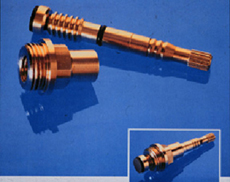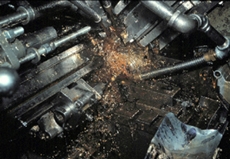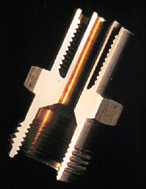Free-Cutting Brass: A Closed Environmental Loop
Copper Applications in Health & Environment
The most widely used brass is also the most efficiently recycled.
This article is about brass, with a particularly close look at the ease and thoroughness with which the metal is recycled. As we shall see, recycling is essential to brass's economics, and it is closely linked to the metal's very positive relationship with environmental stewardship.
But first, a little background reading.
 A household faucet stem machined from Free-Cutting Brass. Insert shows the assembled product.
A household faucet stem machined from Free-Cutting Brass. Insert shows the assembled product.Brass has been around for at least several dozen centuries, and because of its very favorable properties, it is still one of our most useful metals. There are literally dozens of types of brasses in everyday use today. Their common feature is the fact that they all contain copper and zinc, with the latter ranging from about five to forty percent of the alloy's composition by weight. In addition to copper and zinc, brasses may contain small quantities of aluminum, tin, manganese, iron, nickel or lead to impart special properties. Brasses are produced in all common product forms. As sheet and strip, they are used in applications as diverse as architectural cladding and lamp sockets, computer key-boards and jewelry. Foundries use cast brasses for such familiar products as faucets and hardware items, plus a large variety of marine and industrial equipment.
But in terms of total metal consumed, here and elsewhere in the world, the most widely used brasses of all are those made in the form or rods, bars and special shapes, which are machined into finished products. Paramount among these brasses is an alloy containing roughly 60% copper, 2� to 3�% lead and about 37% zinc. It is commonly called Free-Cutting Brass. North American engineers and machinists also know the metal by its official designation, UNS/ANSI Alloy C36000. About one million tons of brasses of all types are consumed in the U.S. alone each year, about half of which are the free-cutting types. Worldwide consumption is several times that figure.
Why "Free-Cutting"?
Free-Cutting refers to alloy C36000's high machinability. Machinability is a catch-all term that describes such important features as the ease with which a metal can be turned, drilled or otherwise cut, the length of time cutting tools remain sharp and the quality of the metal's machined surfaces. No other metal or alloy - and certainly none in its strength class - can be machined faster, longer or more consistently than Free-Cutting Brass. Tests have shown that C36000 can be machined up to five times faster than steel under conditions under which both metals maintain the same cutting tool life.
Environmental Questions
Free-Cutting Brass achieves its high machinability primarily from the few percent of lead contained in the alloy. The lead is distributed in microscopic globules throughout the metal. In that form, the lead helps break up machining chips, keeping them from curling up and interfering with high-speed operations. At the same time, lead provides a helpful lubricating action to the cutting tool. Many free-cutting alloys, including steels, contain lead for this reason. (When lead must be avoided, bismuth or bismuth and selenium can, in some cases, be used instead.)
The presence of lead often raises questions regarding a product's possible effects on environment and health. One common question regarding lead-containing materials such as Free-Cutting Brass regards the possibility that discarded objects or scrap containing the metal will end up in landfills.
 Small fragmented machining chips literally fly away from the cutting tool during high-speed machining of Free-Cutting Brass.
Small fragmented machining chips literally fly away from the cutting tool during high-speed machining of Free-Cutting Brass.Is this likely? And what about all the machine shop scrap left over when brass products are produced; are they simply discarded, too? Fortunately -- for everyone's sake, including brass producers and fabricators as well as users of brass products -- the answer to these questions is a very definite NO.
Brass is almost never intentionally discarded. In the first place, it's simply too valuable. Even in the form of scrap, it can command up to three-quarters of the price of new metal, so every bit of scrap brass that can be gotten hold of is quickly recycled to make new metal.
Even more to the point is the fact that brass itself is almost entirely made from recycled metals. So, rather than contributing to environmental problems, the production and use of brass removes no-longer-used metals from circulation.
Let's look at two situations that show how efficient the brass recycling system is.
Consider automobile radiators, the kind made from copper and brass. Today, most new cars are equipped with aluminum radiators; however, contrary to popular belief, copper and brass still account for about two-thirds by weight of all radiator material currently in use. When old cars are junked, their copper/brass radiators are removed and collected by scrap dealers who prepare the metal for re-use.
Once stripped of any plastic components, the recycled radiators contain only copper, zinc, tin and lead (the tin and lead are in the solder that holds the radiators together). Lead-free copper-and-brass radiators have recently been introduced, but until they find wide acceptance among automakers, conventional copper/brass radiators will continue to be a valuable source of raw materials for the manufacture of brass and other copper alloys.
Scrapped radiators are normally converted to ingots for use in foundries, which use the metal to make cast brasses and bronzes. Other types of scrap brass, such as stampings, brass wire and cartridge cases, eventually reappear as wrought brasses. Free-Cutting Brass represents a special situation. Like other brasses, Free-Cutting Brass is made almost entirely from scrap, but the scrap used in this case is usually in the form of discarded brass articles plus bare, bright copper such as recycled electrical wire and plumbing tube from demolished buildings. Pure new zinc is usually added to make up the proper composition. The most important ingredient of Free-Cutting Brass, however, is used Free-Cutting Brass in the form of machine-shop turnings.
Turnings That Keep Returning
 Cutaway view of a machined brass hose fitting. Note how much metal has been removed.
Cutaway view of a machined brass hose fitting. Note how much metal has been removed.When a machine shop manufactures a part from Free-Cutting Brass (or any other metal, for that matter), it isn't unusual for the weight of chips produced to outweigh the finish-machined product. The hose fitting shown at right illustrates the point very well. In this case, more than 65% of the brass rod used to make the fitting was machined away.
The brass chips produced by machine shops are never thrown away. Instead, they are collected, cleaned and sent back to a brass mill to make more brass rod. The chips are so valuable that a machine shop will often buy its brass with the value of the returned chips already calculated into the price of the new brass rod. It's a very efficient and economical closed cycle. The "scrap" brass never really leaves the loop; it just keeps getting re-used again and again.
The recycling of brass scrap represents a very large business. Each year, nearly a half-billion pounds of turnings such as those shown at left are generated, picked up and delivered back to brass mills, where they are inspected, cleaned again and chemically analyzed before being remelted to make new brass.
 Free-Cutting Brass chips being collected at a typical machine shop.
Free-Cutting Brass chips being collected at a typical machine shop.Is it worth the trouble to handle all that scrap? Absolutely, and everyone wins in the process. The machine shop owner wins because the brass he or she recycles reduces the shop's net cost of raw material. The recycling company wins because it profits from the transfer. The brass mill wins because it is assured of a steady supply of raw material of a known and fixed composition, one that generally needs very little adjusting in the furnace to reproduce the original product. Finally, the environment wins --along with the rest of us -- because virtually none of the billion pounds of brass used in the U.S. each year finds its way to a landfill.
Think about that the next time that you pick up a machined brass product. So far as the environment is concerned, the part of the product you don't see -- the recycled machining chips -- is just as important as the part in your hand.
Contact:
Robert D. Weed
Vice President, Rod, Bar & Mechanical Wire
Automotive and Building Construction
P.O. Box 2504
Birmingham, MI 48012
Tel: 248-642-6980
Fax: 248-642-4770
Email
Also in this Issue:
- xDSL Technology & The Internet (Part II)
- Free-Cutting Brass: A Closed Environmental Loop
- xDSL Deployment
